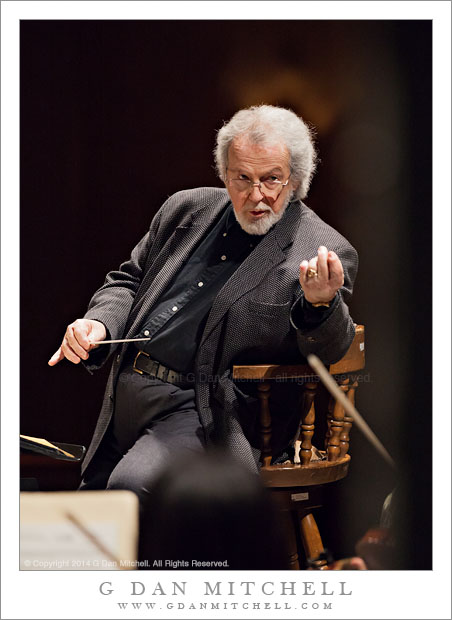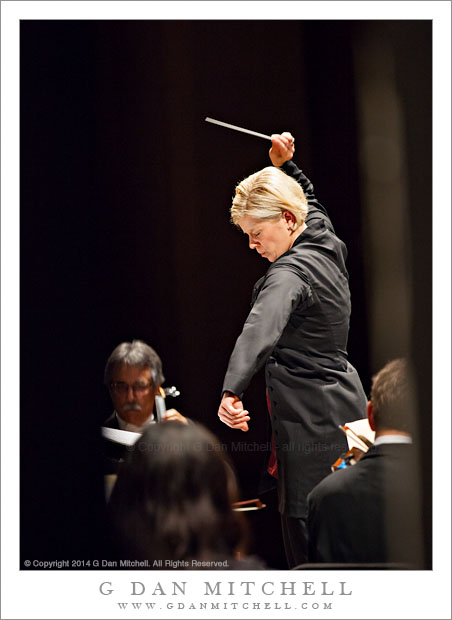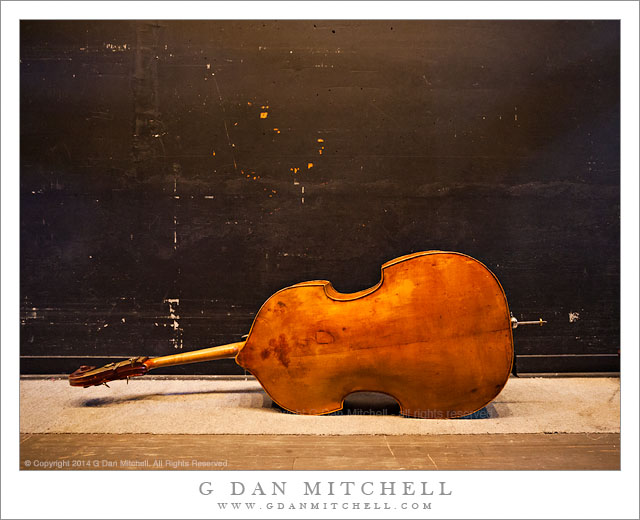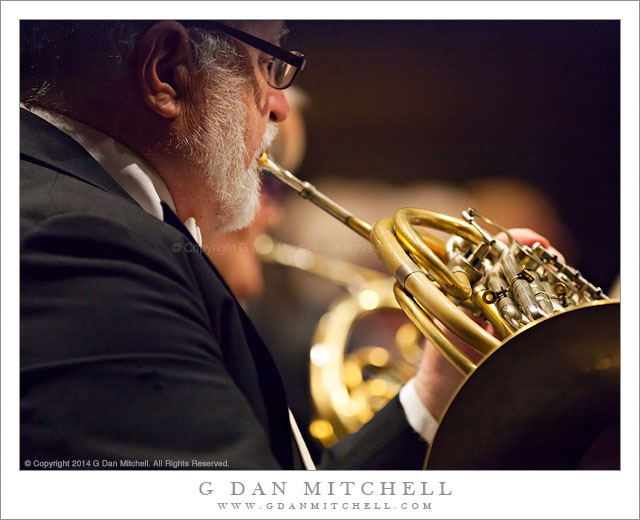
Conductor George Cleve. San Jose, California. June 5, 2014. © Copyright 2014 G Dan Mitchell – all rights reserved.
George Cleve conducts the Symphony Silicon Valley in rehearsal
Bear with me. This may be a long story. I’ll start with some basic facts concerning this photograph. As some of you may know, I have been working on a long-term project to photograph classical musicians. This is related to a sabbatical project at my college, and one goal is to document aspects of the lives and works of classical musicians that might not typically be seen by those who only get to come to see performances. For this purpose, I have been “embedded” with a couple of groups for over a year. It has been a great opportunity, and I’m grateful to the musicians and others who work with them for allowing me a kind of access to their lives and work that they might not afford to just anyone. It helps that I know many of them, that I’m married to one of these musicians, that my academic training is in music, and that I used to perform with people like these. All of that also helps me be sensitive to things that other photographers might not as easily see. (This is a long story in and of itself, and I’ll save that for later.)
The conductor of this concert “set” is George Cleve. His name is not exactly a household word, but his experience and skill and musical sensitivity is of the highest level. My experience with George goes back many years, to a time when he conducted orchestras in which I occasionally played (San Jose Symphony and the Midsummer Mozart Festival Orchestra) and one for which I served as orchestra stage director for a few years. In a surprising coincidence I even took a conducting class from him when I was an under-graduate music major “back in the day.”
Conductors are not always patient people, and there are many reasons that this can be the case. The work they do is unlike almost any other work that I can imagine. Even though I’ve been around music for many years, I still find it difficult to offer a really good description of the complexity of the role—which includes elements of ring-master, leader, coordinator, passionate interpreter, analytical listener and teacher, and much more. Truly watching a skillful conductor—and preferably not while performing, but instead while your full attention can be on the watching—is an illuminating experience. From the visual perspective of a photographer, the appearance of the conductor is in a continuous state of flux. His or her facial expressions change faster than you can follow, and subtle movements—a quick glance, a hint of a smile, a momentary intensity, a curving motion of the hand—convey things in a fluid way.
But I have one more story about George, and it involves that conducting class. His was an intimidating presence for young music students. I recall him at one of the first classes asking, “You do all have the nine symphonies of Beethoven committed to memory, right?” Wrong! Though we quickly set about trying. (That task takes far longer than a college term!) I recall a day when we were to individually conduct the second movement of the 6th symphony for him. As I remember it, we entered the room alone to face him and conduct as a pianist played a reduction of the score. One after another nervous students entered and soon emerged from the room, often seemingly crushed by the realization of how little they understood what they had to do. It was my turn. I entered and faced him and began to conduct. In my recollection, which is probably no longer completely accurate, he quickly stopped me and said something along the lines of, “No, no, no!” But then, for reasons I never quite understood, he gave me a musical gift that I did not expect and which has remained with me since then. Instead of telling me I was done, he said, “Watch me.” Standing a few feet in front of me and conducting as if the full symphony was where I stood, he put on the full show for me, intensity of expression, cues to all, the perfect physical expression of what did and could happen in the music, and I saw what it actually might mean to understand and lead such a performance of such a piece… even if I never learned to do so even close to his level.
This week, at the rehearsals that included a different Beethoven symphony, I finally had the opportunity, decades later, to thank him for that gift.
 G Dan Mitchell is a California photographer and visual opportunist whose subjects include the Pacific coast, redwood forests, central California oak/grasslands, the Sierra Nevada, California deserts, urban landscapes, night photography, and more.
G Dan Mitchell is a California photographer and visual opportunist whose subjects include the Pacific coast, redwood forests, central California oak/grasslands, the Sierra Nevada, California deserts, urban landscapes, night photography, and more.
Blog | About | Flickr | Twitter | Facebook | Google+ | 500px.com | LinkedIn | Email
Text, photographs, and other media are © Copyright G Dan Mitchell (or others when indicated) and are not in the public domain and may not be used on websites, blogs, or in other media without advance permission from G Dan Mitchell.



